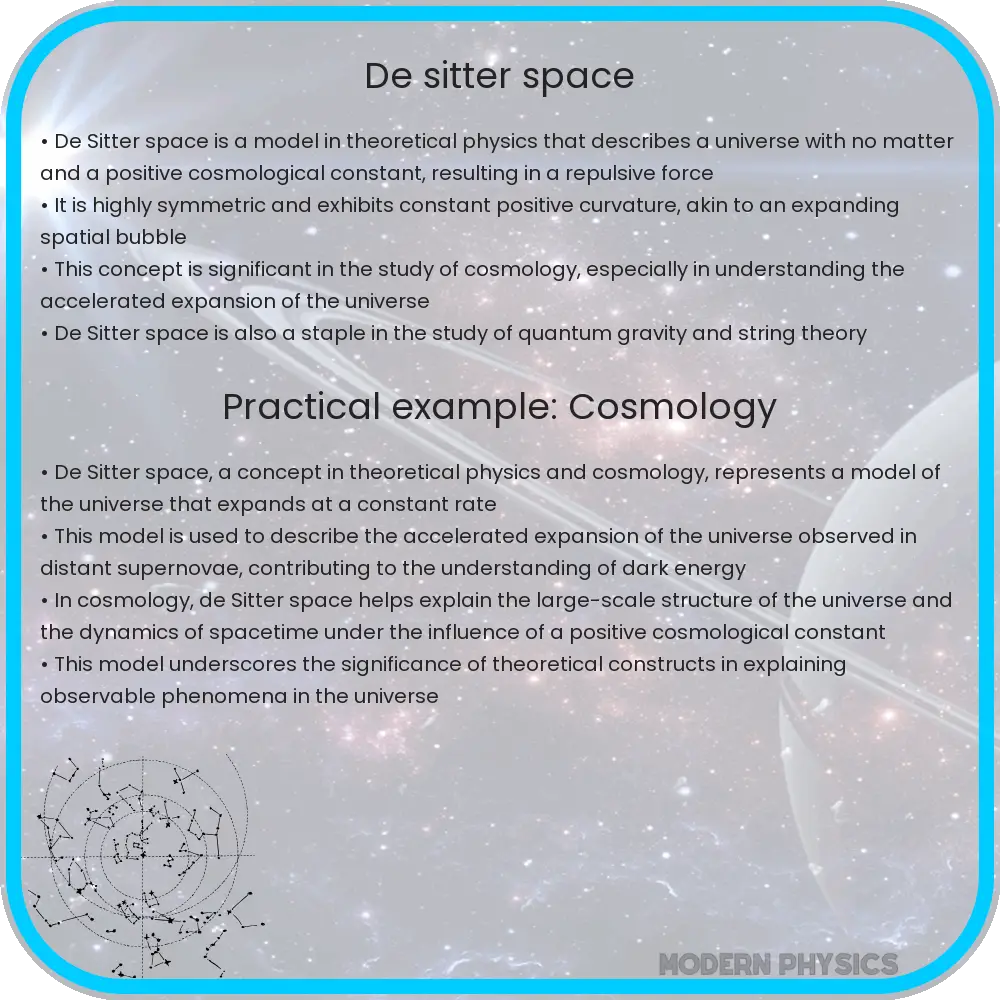Explore the intriguing concept of De Sitter space in modern cosmology.

Understanding De Sitter Space in Modern Cosmology
In the realm of cosmology, the concept of De Sitter space plays a critical role in understanding the accelerating expansion of the universe. Named after Dutch astronomer Willem de Sitter, this model provides a unique perspective on the interplay between cosmology, quantum theory, and the nature of the universe’s expansion.
The Concept of De Sitter Space
De Sitter space is a solution to Einstein’s field equations of General Relativity, representing a universe devoid of matter but with a positive cosmological constant (Λ). This constant is crucial as it suggests a repulsive force, leading to the accelerated expansion of the universe. In a De Sitter universe, space is homogenous and isotropic, meaning it looks the same in all directions and at all points, a property consistent with our observations of the large-scale structure of the cosmos.
De Sitter Space and the Accelerating Universe
The discovery of the universe’s accelerated expansion in the late 1990s was a groundbreaking moment in cosmology. Observations of distant Type Ia supernovae indicated that the universe is not just expanding, but doing so at an increasing rate. This observation lends support to the De Sitter model, as the positive cosmological constant Λ is directly associated with this accelerated expansion.
Quantum Theory and De Sitter Space
Quantum theory further enriches our understanding of De Sitter space. The concept of quantum fluctuations in the vacuum is significant in this context. In a universe described by De Sitter space, these fluctuations can have profound implications, possibly even for the creation of galaxies and large-scale structures. Moreover, the study of quantum field theory in curved spacetime, like that of a De Sitter universe, provides insights into how quantum phenomena might manifest in a gravitationally dynamic environment.
De Sitter space also has implications for the study of the early universe and cosmic inflation. The inflationary model proposes a rapid expansion of space in the early universe, a concept that aligns closely with the properties of De Sitter space. This alignment provides a crucial link between theoretical physics and observational cosmology.
Understanding De Sitter space is not just about grasping a theoretical construct; it’s about connecting the dots between the fundamental forces of nature and the observable dynamics of the cosmos. As we delve deeper into the mysteries of the universe, De Sitter space remains a key element in the cosmological puzzle.
The Role of Dark Energy in De Sitter Cosmology
Central to the discussion of De Sitter space is the enigmatic concept of dark energy. This mysterious force is believed to be responsible for the accelerated expansion of the universe. In the De Sitter model, the cosmological constant Λ is often associated with the energy density of the vacuum of space, a representation of dark energy. The implications of this are far-reaching, as understanding dark energy is pivotal in unraveling the future fate of the universe.
De Sitter Space in String Theory and Theoretical Physics
In the realm of theoretical physics, particularly string theory, De Sitter space poses significant challenges and opportunities. String theory, which attempts to reconcile quantum mechanics and general relativity, has yet to fully incorporate the concept of a De Sitter universe. This is partly due to the complexities arising from the nature of quantum gravity. However, exploring De Sitter space within the framework of string theory could lead to groundbreaking insights into the fundamental laws governing the universe.
Implications for the Future of the Universe
The study of De Sitter space also offers perspectives on the ultimate fate of the universe. If the universe continues to expand under the influence of a positive cosmological constant, it may approach a state close to that described by De Sitter space. In such a scenario, the universe could continue expanding indefinitely, leading to a cold, empty, and dark future, often referred to as the “Big Freeze.
Conclusion: The Significance of De Sitter Space in Cosmology
De Sitter space is more than a theoretical construct; it is a bridge between the abstract realms of quantum theory and the observable phenomena of cosmology. Its relevance to the study of the universe’s accelerating expansion, dark energy, and the fate of the cosmos underscores its importance. As research progresses, the insights gleaned from De Sitter space may hold the keys to understanding not only the vastness of the cosmos but also the intricate details of the fabric of space and time. Thus, De Sitter space remains a fundamental concept in modern cosmology, challenging and enlightening our quest to comprehend the universe.
